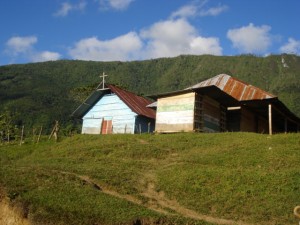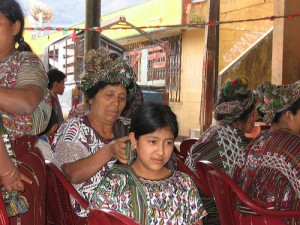The Ixil Triangle's uniqueness and exciting cultural richness have made it one of the favorite destinations of hikers in Guatemala. The Triangle is located north of the Sierra de los Cuchumatanes. Lying just below the Peten rainforest, the Triangle is formed by three small towns and their surrounding villages: Santa María Nebaj, San Juan Cotzal and San Gaspar Chajul.

Mountains, Ixil Triangle, photo by Renata Avila
On his travel blog, Jay Nichvolodov described his experience in Santa María Nebaj:
Nebaj's quite a stunning place, really. It's just cradled between mountains. Really, I don't know if I can describe it, it's just like the city's in the middle of cupped mountain hands. Mist rolls through the vividly green hills, shrouding everything around Nebaj. It's an unusual place (like most places in Guatemala) culturally too, because the women (or many, at least) continue a dress tradition where a strange little pom-pom rope is winded through their hair. The colours are different in Nebaj too, with lots of greens.

Traditional blouse, Chajul, photo by Renata Avila
To understand better the Ixil women, it is necessary to take a look of their traditional clothing. Their blouses communicate their personal identity, their heritage, and their beliefs. Linda traveled to one of the Ixil Triangle villages, Chajul, and she was especially touched by the clothing:
You can hardly imagine the mountains of one-of-a-kind backstrap-woven huipil (blouses) that we encountered in the markets. Or the weavers we met who invited us into their homes and offered us fresh, hand-formed tortillas from their meager stores. Each community had a distinctive style, yet each textile was as fresh as the imagination of its weaver… This little video is a snapshot of our experience in the village of Chajul.

Photo by Amareto CR. Used following a Creative Commons License: http://www.flickr.com/photos/amarethos/2489306689/
The Ixil Triangle is home to the Alol o’tlayol, the community storytellers, who are the keepers of myths and legends of the region. The blog Guatezona shares one of their stories [es]:
En Nebaj se cuenta que Tznxelal Almika -Corazón del Cielo- era muy cercano a los ixiles, pero éstos comenzaron a espiarlo. Debido a ello, dispuso castigarlos con una lluvia de fuego. A los sobrevivientes se les asignó la tarea de cuidar a los hombres y son conocidos como “Señores de los Cerros”.
The Nebaj village of Hacienda San Antonio [es] in Acul is known for a particular product: cheese. Blogger La Casa k-d1 shares the story of Don Giuseppe Azzari [es], an Italian cheese farmer who arrived in 1932 and made his dream a reality in the Ixil Triangle:
Azzari, un italiano quesero artesanal, vivió en la frontera con los Alpes Suisos, ahora las nuevas generaciones ofrecen a usted el delicioso queso artesanal que conserva la receta original. “Il Formaggio di Chancol” es un excelente producto único en Guatemala.
The Ixil Triangle was an area billed as the hotbed of Guatemala's armed conflict. The three towns sit up in the Northern region of the department of Quiché where, according to the UN-sponsored truth commission, over 300 separate massacres took place during the war (map). Today, ixiles share the uniqueness of a community of less than 70,000 inhabitants [es].







2 comments
Renata, what a wonderful post. I would love to go to the Ixil Triangle someday. Guatemala is a beautiful country.
I am rushing to write this note because of emotions associated with your article/work in the Ixil Country. Mt memories go back tothe early seventy’s when I spend the most wonderful part of my entire life. Please allow me tobe in contact with you tofurther inquire about the people I met in this wonderful part of Guatemala.